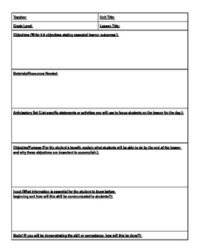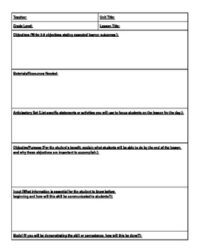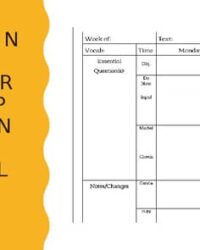Crafting an effective lesson can feel like an art form, a delicate balance of engagement, clear objectives, and thorough instruction. For many educators, navigating the complexities of lesson design is a journey of continuous improvement. This is where a structured approach, like the one offered by the renowned Hunter Method, truly shines. It provides a robust framework that helps ensure every minute in the classroom is purposeful and productive, guiding both new teachers and seasoned professionals toward more impactful teaching.
Imagine having a clear roadmap for every single lesson, ensuring you hit all the critical points necessary for student understanding and retention. That’s precisely what the Hunter Method aims to provide. Its systematic steps are designed to keep lessons focused, students engaged, and learning outcomes consistently met. Adopting a well-designed hunter method lesson plan template can transform your preparation process, making it more efficient and your lessons more successful.
Unpacking the Hunter Method Framework for Effective Teaching
The Hunter Method, developed by Dr. Madeline Hunter, revolutionized lesson planning by breaking down the instructional process into distinct, manageable steps. It’s not just a checklist; it’s a pedagogical philosophy centered on ensuring clarity for students and systematic delivery for teachers. This framework emphasizes proactive planning, focusing on how students will learn, not just what they will learn. Its structure provides a predictable flow that helps students anticipate what’s next, reducing anxiety and increasing their capacity to absorb new information.
At its core, the Hunter Method outlines seven key components that contribute to a high-quality lesson. These include the objective, anticipatory set, input, modeling, guided practice, checking for understanding, and independent practice. Each step serves a vital purpose, from grabbing students’ attention at the start to solidifying their learning by the end. Teachers who consistently apply these principles often report increased student engagement and improved academic performance, as the method naturally encourages active participation and constant feedback loops.
One of the significant advantages of using this method is its adaptability. While the steps are consistent, the content within each step is entirely flexible, allowing educators to tailor lessons to specific subjects, grade levels, and student needs. Whether you’re teaching math, literature, science, or history, the fundamental structure remains a powerful guide. It ensures that no crucial element of effective instruction is overlooked, leading to comprehensive and cohesive learning experiences for every student in the classroom.
Utilizing a dedicated hunter method lesson plan template further streamlines this process. These templates often provide prompts and sections for each of the seven steps, ensuring that teachers consider every aspect of the lesson before stepping in front of their class. This proactive approach minimizes improvisation and maximizes instructional time, creating a more professional and effective learning environment.
Key Components of the Hunter Method
- Objectives: What will students learn or be able to do by the end of the lesson? Clear, measurable goals are essential.
- Anticipatory Set: How will you capture students’ attention and link to prior knowledge? This hook sets the stage.
- Input: What information will be taught? This includes new content, concepts, and skills.
- Modeling: How will you demonstrate the skill or concept? “I do” is crucial for showing expected performance.
- Guided Practice: How will students practice with teacher support? “We do” allows for immediate feedback.
- Checking for Understanding: How will you assess if students grasp the content? Informal and formal checks ensure no one is left behind.
- Independent Practice: How will students practice on their own? “You do” solidifies learning without direct teacher intervention.
- Closure: How will you summarize the lesson and prepare for future learning? A thoughtful wrap-up helps retention.
Benefits for Teachers and Students
For teachers, the Hunter Method brings a sense of order and confidence to lesson preparation. It reduces the stress of “what to do next” by providing a logical progression. For students, this structure translates into clearer expectations and a more predictable learning environment, which can be particularly beneficial for those who thrive on routine or need extra support in organizing new information. It fosters an active learning environment where students are regularly engaged and their understanding is consistently monitored.
Customizing Your Lesson Plan with the Hunter Method
While the Hunter Method provides a rigid framework, its strength truly lies in its adaptability. You can take the foundational steps and infuse them with your unique teaching style, the specific needs of your students, and the demands of your curriculum. Think of the template as a skeleton; you bring the muscles, organs, and personality to make it a living, breathing lesson. This means adjusting the time spent on each segment, selecting appropriate activities for input or practice, and crafting a captivating anticipatory set relevant to your learners’ interests.
For instance, an anticipatory set in a history class might involve a compelling primary source image, while in a math class, it could be a quick warm-up problem that connects to the new concept. The “input” might be a lecture, a video, or a collaborative reading activity, depending on the subject matter and learning objectives. Similarly, guided practice can range from pair work and small group discussions to whole-class problem-solving, all while you provide immediate feedback and clarify misconceptions.
The beauty of a robust hunter method lesson plan template is that it encourages this thoughtful customization. It prompts you to consider every facet of the lesson rather than just presenting content. This systematic planning ensures that you are not only delivering information but also scaffolding learning, checking for comprehension, and providing ample opportunities for students to apply new knowledge independently. It turns teaching into a more deliberate and ultimately more effective practice, ensuring that every minute counts toward genuine student growth and understanding.
Embracing a structured approach to lesson planning, like that offered by the Hunter Method, is more than just a procedural task; it’s an investment in the quality of education you provide. It empowers educators to design lessons that are not only comprehensive but also dynamic and deeply resonant with their students. By systematically addressing each phase of learning, from initial engagement to independent application, teachers can cultivate an environment where understanding blossoms and academic success becomes a consistent outcome.
Ultimately, a well-implemented Hunter Method framework helps bridge the gap between teaching and true learning. It provides a reliable blueprint for consistent, high-quality instruction, allowing teachers to focus less on “what to do next” and more on the magic of facilitating discovery. The result is a more confident educator and, most importantly, more capable and engaged learners ready to tackle new challenges.


